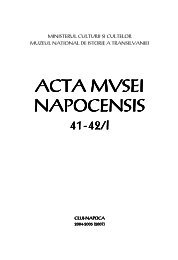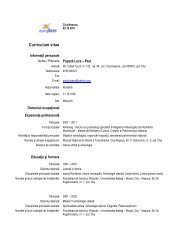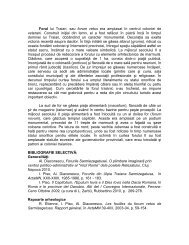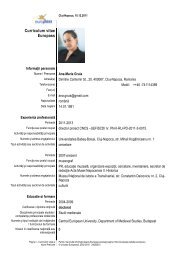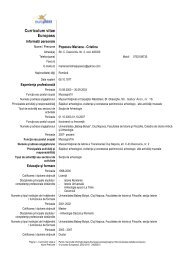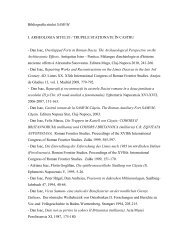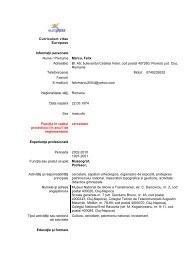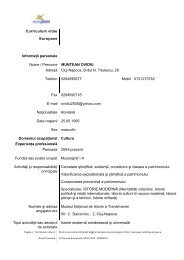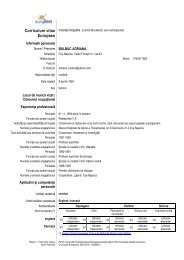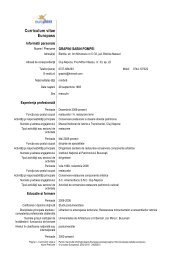- Page 1 and 2: MINISTERUL CULTURII ŞI CULTELOR MU
- Page 3 and 4: CONTENTS - INHALT - SOMMAIRE Mihai
- Page 5 and 6: Acta Musei Napocensis, 43-44/I, 200
- Page 7: Economical life in Noua Culture Ref
- Page 11 and 12: Economical life in Noua Culture The
- Page 13 and 14: Economical life in Noua Culture In
- Page 15 and 16: Economical life in Noua Culture bre
- Page 17 and 18: Economical life in Noua Culture Wes
- Page 19 and 20: Economical life in Noua Culture 80%
- Page 21 and 22: Economical life in Noua Culture pie
- Page 23 and 24: Economical life in Noua Culture 7.
- Page 25 and 26: Economical life in Noua Culture Cha
- Page 27 and 28: Economical life in Noua Culture Cav
- Page 29 and 30: Ordentlich, Chidioşan 1975 Economi
- Page 31 and 32: Economical life in Noua Culture Pl.
- Page 33 and 34: Economical life in Noua Culture Pl.
- Page 35 and 36: Economical life in Noua Culture Pl.
- Page 37 and 38: Economical life in Noua Culture Pl.
- Page 39 and 40: Economical life in Noua Culture 39
- Page 41 and 42: Economical life in Noua Culture Pl.
- Page 43 and 44: Economical life in Noua Culture Pl.
- Page 45 and 46: Economical life in Noua Culture Pl.
- Page 47 and 48: Acta Musei Napocensis, 43-44/I, 200
- Page 49 and 50: Floreşti-Polus Center. Preliminary
- Page 51 and 52: Floreşti-Polus Center. Preliminary
- Page 53 and 54: Floreşti-Polus Center. Preliminary
- Page 55 and 56: Floreşti-Polus Center. Preliminary
- Page 57 and 58: Floreşti-Polus Center. Preliminary
- Page 59 and 60:
Floreşti-Polus Center. Preliminary
- Page 61 and 62:
Floreşti-Polus Center. Preliminary
- Page 63 and 64:
Floreşti-Polus Center. Preliminary
- Page 65 and 66:
Floreşti-Polus Center. Preliminary
- Page 67 and 68:
Floreşti-Polus Center. Preliminary
- Page 69 and 70:
Floreşti-Polus Center. Preliminary
- Page 71 and 72:
Floreşti-Polus Center. Preliminary
- Page 73 and 74:
Floreşti-Polus Center. Preliminary
- Page 75 and 76:
Floreşti-Polus Center. Preliminary
- Page 77 and 78:
Floreşti-Polus Center. Preliminary
- Page 79 and 80:
Floreşti-Polus Center. Preliminary
- Page 81 and 82:
Floreşti-Polus Center. Preliminary
- Page 83 and 84:
Floreşti-Polus Center. Preliminary
- Page 85 and 86:
Floreşti-Polus Center. Preliminary
- Page 87 and 88:
Floreşti-Polus Center. Preliminary
- Page 89 and 90:
Acta Musei Napocensis, 43-44/I, 200
- Page 91 and 92:
Pre-Roman Dacia within the trade wi
- Page 93 and 94:
Pre-Roman Dacia within the trade wi
- Page 95 and 96:
Pre-Roman Dacia within the trade wi
- Page 97 and 98:
Pre-Roman Dacia within the trade wi
- Page 99 and 100:
Pre-Roman Dacia within the trade wi
- Page 101 and 102:
Pre-Roman Dacia within the trade wi
- Page 103 and 104:
Pre-Roman Dacia within the trade wi
- Page 105 and 106:
Pre-Roman Dacia within the trade wi
- Page 107 and 108:
Pre-Roman Dacia within the trade wi
- Page 109 and 110:
Pre-Roman Dacia within the trade wi
- Page 111 and 112:
Acta Musei Napocensis, 43-44/I, 200
- Page 113 and 114:
Emperor worship in Latin settlement
- Page 115 and 116:
Emperor worship in Latin settlement
- Page 117 and 118:
Emperor worship in Latin settlement
- Page 119 and 120:
Emperor worship in Latin settlement
- Page 121 and 122:
Emperor worship in Latin settlement
- Page 123 and 124:
Emperor worship in Latin settlement
- Page 125 and 126:
Emperor worship in Latin settlement
- Page 127 and 128:
Emperor worship in Latin settlement
- Page 129 and 130:
Emperor worship in Latin settlement
- Page 131 and 132:
Emperor worship in Latin settlement
- Page 133 and 134:
Emperor worship in Latin settlement
- Page 135 and 136:
Emperor worship in Latin settlement
- Page 137 and 138:
Emperor worship in Latin settlement
- Page 139 and 140:
Emperor worship in Latin settlement
- Page 141 and 142:
Emperor worship in Latin settlement
- Page 143 and 144:
LOCATION Emperor worship in Latin s
- Page 145 and 146:
Emperor worship in Latin settlement
- Page 147 and 148:
Emperor worship in Latin settlement
- Page 149 and 150:
Emperor worship in Latin settlement
- Page 151 and 152:
Acta Musei Napocensis, 43-44/I, 200
- Page 153 and 154:
L’inscription monumentale de l’
- Page 155 and 156:
L’inscription monumentale de l’
- Page 157 and 158:
L’inscription monumentale de l’
- Page 159 and 160:
L’inscription monumentale de l’
- Page 161 and 162:
L’inscription monumentale de l’
- Page 163 and 164:
Acta Musei Napocensis, 43-44/I, 200
- Page 165 and 166:
Note sur le territorium Arcobadaren
- Page 167 and 168:
Acta Musei Napocensis, 43-44/I, 200
- Page 169 and 170:
La cohors I Augusta Ituraeorum en D
- Page 171 and 172:
La cohors I Augusta Ituraeorum en D
- Page 173 and 174:
La cohors I Augusta Ituraeorum en D
- Page 175 and 176:
La cohors I Augusta Ituraeorum en D
- Page 177 and 178:
Acta Musei Napocensis, 43-44/I, 200
- Page 179 and 180:
L’aigle de la legio XIII Gemina u
- Page 181 and 182:
L’aigle de la legio XIII Gemina c
- Page 183 and 184:
L’aigle de la legio XIII Gemina P
- Page 185 and 186:
Acta Musei Napocensis, 43-44/I, 200
- Page 187 and 188:
Neue Diplome für die dakischen Pro
- Page 189 and 190:
Neue Diplome für die dakischen Pro
- Page 191 and 192:
Neue Diplome für die dakischen Pro
- Page 193 and 194:
Neue Diplome für die dakischen Pro
- Page 195 and 196:
Neue Diplome für die dakischen Pro
- Page 197 and 198:
Neue Diplome für die dakischen Pro
- Page 199 and 200:
Neue Diplome für die dakischen Pro
- Page 201 and 202:
Neue Diplome für die dakischen Pro
- Page 203 and 204:
Neue Diplome für die dakischen Pro
- Page 205 and 206:
Neue Diplome für die dakischen Pro
- Page 207 and 208:
Neue Diplome für die dakischen Pro
- Page 209 and 210:
3. Dacia inferior (12 Konstitutione
- Page 211 and 212:
Acta Musei Napocensis, 43-44/I, 200
- Page 213 and 214:
Paraderüstungen aus Dakien 2. Apul
- Page 215 and 216:
Paraderüstungen aus Dakien Stücke
- Page 217 and 218:
Paraderüstungen aus Dakien Panzerb
- Page 219 and 220:
Paraderüstungen aus Dakien Dragot
- Page 221 and 222:
Paraderüstungen aus Dakien Abb. 3.
- Page 223 and 224:
Abb. 7. Samum (Căşeiu). Linke Wan
- Page 225 and 226:
Paraderüstungen aus Dakien Abb. 10
- Page 227 and 228:
Abb. 16. Visegrád (Unterpannonien)
- Page 229 and 230:
Paraderüstungen aus Dakien Abb. 22
- Page 231 and 232:
Paraderüstungen aus Dakien Abb. 26
- Page 233 and 234:
Acta Musei Napocensis, 43-44/I, 200
- Page 235 and 236:
The peregrine names from Dacia Disc
- Page 237 and 238:
The peregrine names from Dacia of e
- Page 239 and 240:
The peregrine names from Dacia Tabl
- Page 241 and 242:
The peregrine names from Dacia who,
- Page 243 and 244:
The peregrine names from Dacia Sena
- Page 245 and 246:
The peregrine names from Dacia some
- Page 247 and 248:
Acta Musei Napocensis, 43-44/I, 200
- Page 249 and 250:
The auxiliary iunfantry in Roman Da
- Page 251 and 252:
The auxiliary iunfantry in Roman Da
- Page 253 and 254:
The auxiliary iunfantry in Roman Da
- Page 255 and 256:
The auxiliary iunfantry in Roman Da
- Page 257 and 258:
The auxiliary iunfantry in Roman Da
- Page 259 and 260:
The auxiliary iunfantry in Roman Da
- Page 261 and 262:
The auxiliary iunfantry in Roman Da
- Page 263 and 264:
Acta Musei Napocensis, 43-44/I, 200
- Page 265 and 266:
Speculatores in Dacia They most pro
- Page 267 and 268:
Speculatores in Dacia Some speculat
- Page 269 and 270:
Speculatores in Dacia At the other
- Page 271 and 272:
Speculatores in Dacia having return
- Page 273 and 274:
Speculatores in Dacia place availab
- Page 275 and 276:
Speculatores in Dacia About the hea
- Page 277 and 278:
Speculatores in Dacia The admittanc
- Page 279 and 280:
Speculatores in Dacia CIL III 14479
- Page 281 and 282:
Acta Musei Napocensis, 43-44/I, 200
- Page 283 and 284:
In memorian Adela Paki Probablement
- Page 285 and 286:
In memorian Adela Paki Bibliografia
- Page 287 and 288:
Acta Musei Napocensis, 43-44/I, 200
- Page 289:
Abbreviations - Abkürzungen - Abr



